
Echinopsis is a genus of cacti native to South America, sometimes known as hedgehog cactus, sea-urchin cactus or Easter lily cactus. As of October 2023, there are about 20 accepted species, ranging from large and treelike types to small globose cacti. The name derives from echinos hedgehog or sea urchin, and opsis appearance, a reference to these plants' dense coverings of spines.

Stetsonia coryne, the toothpick cactus, is the sole species in the cactus genus Stetsonia. Stetsonia coryne is native to arid regions of South America, where it grows to a height of 15 to 25 ft tall. It contains mescaline and other alkaloids.

Geohintonia mexicana is a species of cacti, the only species in the genus Geohintonia. This genus is named after its discoverer George S. Hinton. As its specific epithet suggests, the plant is found in Mexico, where it grows on gypsum hills near Galeana.

Soehrensia spachiana, commonly known as the golden torch, (white) torch cactus or golden column, is a species of cactus native to South America. Previously known as Trichocereus spachianus for many years, it is commonly cultivated as a pot or rockery plant worldwide. It has a columnar habit, with a lime-green cylindrical body with 1–2 cm long golden spines.

Trichocereus macrogonus, synonym Echinopsis macrogonus, is a species of cactus found in Ecuador, Peru and Bolivia. Two varieties are accepted as of September 2023: var. macrogonus and var. pachanoi. Plants contain varying amounts of the psychoactive alkaloid mescaline. They have been used both ritually and in traditional medicine from pre-Columbian times. Trichocereus macrogonus is one of a number of similar species that may be called San Pedro cactus. Indigenous names include achuma and huachuma, although these too may be applied to similar species.
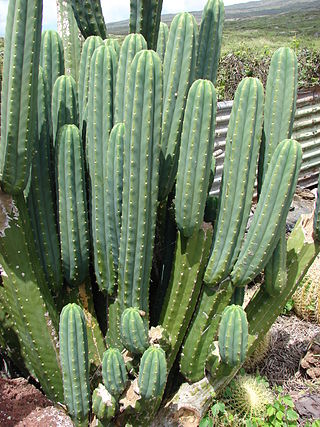
Trichocereus macrogonus var. pachanoi is a fast-growing columnar cactus found in the Andes at 2,000–3,000 m (6,600–9,800 ft) in altitude. It is one of a number of kinds of cacti known as San Pedro cactus. It is native to Ecuador, Peru and Colombia, but also found in Argentina, Bolivia, Chile and Venezuela and cultivated in other parts of the world. Uses for it include traditional medicine and traditional veterinary medicine, and it is widely grown as an ornamental cactus. It has been used for healing and religious divination in the Andes Mountains region for over 3,000 years.
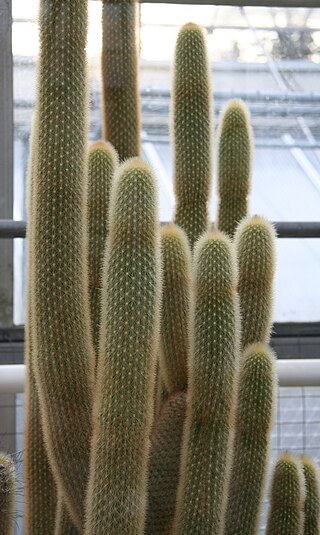
Haageocereus fascicularis commonly known as 'Quisco de la precordillera de Arica' is a species of cactus from the family Cactaceae. It is endemic to southern Peru and northern Chile.
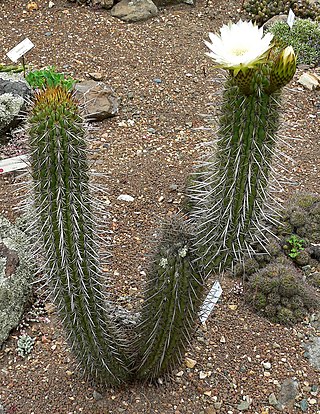
Leucostele chiloensis is a species of cactus native to South America; genus members are known as hedgehog cacti, sea-urchin cactus or Easter lily cactus.

Leucostele atacamensis (cardón) is a species of cactus from Chile, Argentina and Bolivia. The wood of this species can be used in building and in making furniture.

Leucostele terscheckii, commonly known as the cardon grande cactus or Argentine saguaro, is a large cactus native to South America and popular in cultivation.

Echinopsis tacaquirensis, is a species of Echinopsis cactus found in Bolivia.
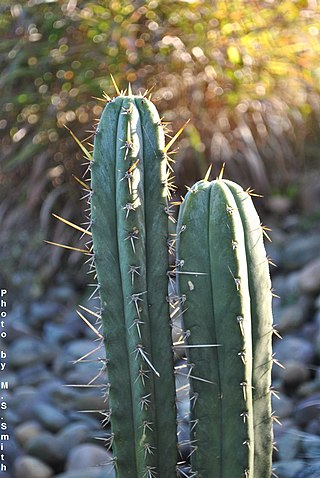
Trichocereus uyupampensis, is a species of Trichocereus found in Chile and Peru.

Leucostele deserticola is a species of cactus native to South America.

Leucostele litoralis is a species of Leucostele found in Chile.
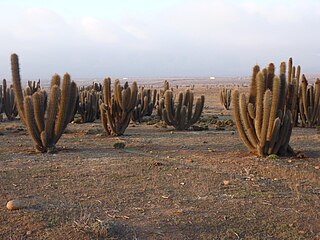
Leucostele skottsbergii is a species of Leucostele found in Chile.
Leucostele tunariensis is a species of columnar cactus native to South America.
Trichocereus spinibarbis, or quisco, is a species of cactus found in Chile.
Leucostele pectinifera is a species of Leucostele found in Chile.
Leucostele undulosa is a species of Leucostele found in Chile.
Leucostele bolligeriana is a species of cactus found in Chile.














